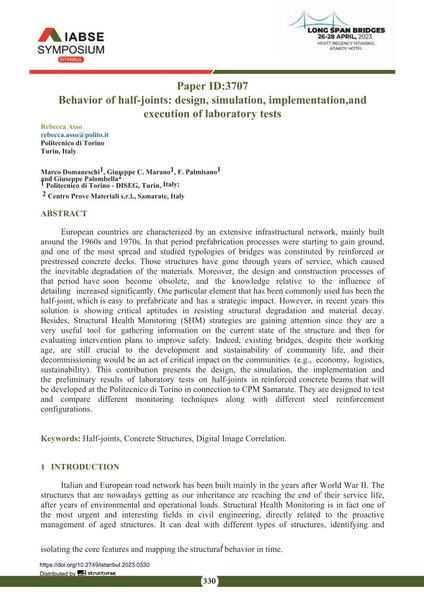Behavior of half-joints: design, simulation, implementation,and execution of laboratory tests

|
|
|||||||||||
Bibliographic Details
| Author(s): |
Rebecca Asso
(Politecnico di Torino Turin, Italy)
Marco Domaneschi (Politecnico di Torino - DISEG, Turin, Italy) Giuseppe C. Marano (Politecnico di Torino - DISEG, Turin, Italy) F. Palmisano (Politecnico di Torino - DISEG, Turin, Italy) Giuseppe Palombella (Centro Prove Materiali s.r.l., Samarate, Italy) |
||||
|---|---|---|---|---|---|
| Medium: | conference paper | ||||
| Language(s): | English | ||||
| Conference: | IABSE Symposium: Long Span Bridges, Istanbul, Turkey, 26-28 April 2023 | ||||
| Published in: | IABSE Symposium Istanbul 2023 | ||||
|
|||||
| Page(s): | 330-335 | ||||
| Total no. of pages: | 6 | ||||
| Year: | 2023 | ||||
| DOI: | 10.2749/istanbul.2023.0330 | ||||
| Abstract: |
European countries are characterized by an extensive infrastructural network, mainly built around the 1960s and 1970s. In that period prefabrication processes were starting to gain ground, and one of the most spread and studied typologies of bridges was constituted by reinforced or prestressed concrete decks. Those structures have gone through years of service, which caused the inevitable degradation of the materials. Moreover, the design and construction processes of that period have soon become obsolete, and the knowledge relative to the influence of detailing increased significantly. One particular element that has been commonly used has been the half-joint, which is easy to prefabricate and has a strategic impact. However, in recent years this solution is showing critical aptitudes in resisting structural degradation and material decay. Besides, Structural Health Monitoring (SHM) strategies are gaining attention since they are a very useful tool for gathering information on the current state of the structure and then for evaluating intervention plans to improve safety. Indeed, existing bridges, despite their working age, are still crucial to the development and sustainability of community life, and their decommissioning would be an act of critical impact on the communities (e.g., economy, logistics, sustainability). This contribution presents the design, the simulation, the implementation and the preliminary results of laboratory tests on half-joints in reinforced concrete beams that will be developed at the Politecnico di Torino in connection to CPM Samarate. They are designed to test and compare different monitoring techniques along with different steel reinforcement configurations. |
||||
| Keywords: |
Concrete Structures digital image correlation Half-joints
|
||||
